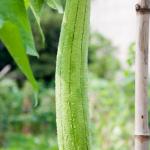Growing Luffa, also Loofah, plant sponge
Cucurbitcaea : Cucurbitaceae / the gourd family
| Jan | Feb | Mar | Apr | May | Jun | Jul | Aug | Sep | Oct | Nov | Dec |
|---|---|---|---|---|---|---|---|---|---|---|---|
| S | S | ||||||||||
| T | |||||||||||
| P | P |
(Best months for growing Luffa in USA - Zone 7b regions)
- S = Plant undercover in seed trays
- T = Plant out (transplant) seedlings
- P = Sow seed
- Grow in seed trays, and plant out in 4-6 weeks. Sow seed at a depth approximately three times the diameter of the seed. Best planted at soil temperatures between 68°F and 86°F.
- Space plants: 18 - 30 inches apart
- Harvest in 11-12 weeks. Use as a back scratcher.
- Compatible with (can grow beside): Peas, Beans, Onions, Sweetcorn
- Avoid growing close to: Potatoes
This type of squash while not strictly a vegetable can be eaten when young. They are more commonly grown to use when mature and dried.
The plants need warmth to grow successfully. Keep inside until all risk of frost is gone.
They grow on vines similar to cucumbers.
A large loofa makes a great back scratcher. Luffa can be cut into many shapes for scrubbing pads, padding, and other uses.
Culinary hints - cooking and eating Luffa
The luffa flowers and fruits are soft and edible when young and are sometimes cooked and eaten like squash or okra. Loofah has been an important food source in many Asian cultures. The leaves and vines should not be eaten.


Your comments and tips